Steven Pressfield's Blog, page 76
October 28, 2015
Who R U?
Why do we write? Most of us, if we’re honest, probably can’t answer that question.
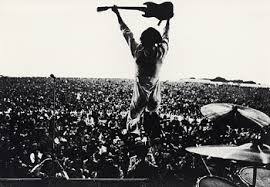
The Who at Woodstock. “Who … who … who are you?”
That’s not a bad thing.
What I mean is, the reasons that compel us as artists to do the work we do are often (if not always) so deep and so hidden that we’re kidding ourselves if we claim we can name them or understand them.
If you’re a writer, you’re compelled to write. Just like a dancer has “gotta dance” or a singer has to sing.
Why?
I believe in destiny. Each of us is unique, I believe, and every one of us was put here for a reason. That destiny lives inside us. It has been there from birth, and maybe (probably) before that. We can’t see it, we can’t touch it, we can’t measure it. But we can feel it.
It’s our daimon. Our genius. Our calling.
But what’s behind this compulsion? What produces it?
Is there some Supreme Consciousness somewhere? A Grand Plan? Has each of us been assigned a part in some mysterious (to us) cosmic design?
Is the human being compelled to understand herself, or at least to try?
Why are so many stories (if not all stories) about self-discovery and self-revelation?
The hero starts out blind to her truth and winds up awake to it, or at least to part of it. The ending may be happy, it may be tragic, it may be sadder-but-wiser. But one way or another, the process of living through the story reveals truth, uncovers character.
Who are we?
Who am I?
Who are you?
If you’re an artist, I believe, you find that out over time by the works you produce. What comes out of you tells you who you are and what your calling is.
I don’t know if it’s true for others but for me, the stuff I’ve written has always popped out as a surprise to me. I never anticipated any of it. There was no scheme or script, no five-year plan.
An idea seized me and I was compelled to write it. Almost always the subject matter was something I knew nothing about at the start and didn’t even know I cared about. In truth I didn’t care about it. Until I got into it. Then I became possessed by it.
I discovered, each time, not so much that I “knew” the subject but that I was powerfully predisposed toward it. I had an aptitude for understanding it. It felt natural. I felt at home.
Who sent these ideas to me?
Why was I so compatible with them?
Did some intelligence pick me to produce these specific works? What intelligence? Is it something inside me?
Are all forms of sentient life compelled to ask and answer, “Who am I? What is the meaning of my life?” Is that our overriding obsession, yours and mine, beyond even survival and procreation?
Or is that compulsion specific to artists?
Do you and I live more than one lifetime?
If it were possible to chart all our incarnations back-to-back, would the flow indicate some single dominating theme? Do Bob Dylan’s songs pick up, in some way, from his work or deeds in some previous appearance here on the planet?
Is he working toward something?
What?
Why?
Is there a purpose?
Whose purpose?
We’re all conscious, I believe, of some force beneath the surface of things. A theme of a number of my fictional pieces, particularly those set in the ancient world, is the idea of Necessity.
Necessity, as I define it in these pieces, is the future. It is That Which Will Be. That Which Must Be.
The politician and the general serve the future in one way, the mother serves it in another. You and I as artists serve it too.
Do we know why?
Am I deluding myself to even entertain this notion?
Then why am I compelled—I mean really compelled—to write what I write? Why are you?
What force is propelling us?
In the end, I can’t say why I write. I don’t know. I know if I don’t write it (or at least try to), I’m miserable.
Who’s running the show here?
Am I at the mercy of my daimon?
Are you?
Is that a bad thing or a good thing?
I don’t know.
October 23, 2015
The Most Important Tool In Your Arsenal
Say thank you
As in, on a card.
No cold, white, computer paper.
In your own handwriting.
With a pen that isn’t running out of ink.
Sharpies are nice. I like thin and medium tipped.
It’s a good way to connect. They’ll remember you.
Of the thousands of books Black Irish gives away every year? I remember the ones who say thank you. The e-mails are in the dozens. The hand-written notes? Count them on my hands.
When I work with clients? There’s a long list of moving pieces. The never-cut, most-often repeated one? The thank you.
I served up Mama and her trolls two weeks ago. The positive force canceling her crazy clan’s negative? The thank you.
Two short, powerful words.
If you’re at a loss on how to make a new connection… Start with a thank you. But…
Mean it.
Don’t do it because you want something in return, even though you do kind of hope something will come in return.
Be gracious.
Be genuine.
Be real.
Kindness is appreciated. When you send it out. It will return.
October 21, 2015
Adding Steps
This post goes out with thanks to my friend Derick, who taught me a type of Resistance I had never thought of (or at least had never given a name to.)
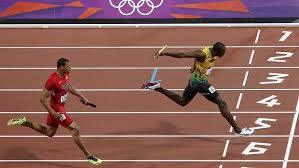
Usain Bolt. Resistance is always strongest at the finish line.
Derick had been working for months on two big projects of his own. He was getting really close to the finish of both, when all of a sudden job offers started coming in. He was offered a teaching post. A movie wanted him to come on board. Two other plum positions opened up, begging him to join.
Guess what happened to his two big projects.
A month later Derick and I were talking. “I let ‘em both drop,” he said, cursing himself. “Then I realized what I was doing. I was adding steps between almost-finished and actually-finished.”
I thought, “Wow, that’s a new one. Adding steps. I love it.”
Isn’t it strange, too, how the universe steps in to screw us up? The rule of thumb for the finish of projects is, “Resistance is always strongest at the finish line.” Somehow that diabolical force can even produce job offers and “opportunities” at just the right time to knock us off course.
The more I thought about it, the more I realized that this type of thing happened to me too. Or I should say, “I let it happen.” I accepted a research position once that I had no interest in. I’ve signed up for movies that had nothing to do with my vision for myself. Right at the finish of Something Big of my own. Arrrgggh.
My first literary agent, many years ago, was a gentleman named Bart Fles. Bart was over ninety when he started representing me and very wise in the ways of the lit biz. He used to ask me, as I approached the end of a manuscript, “How close are you to finishing?”
“Close, Bart. I’m really close.”
“Close is good enough,” Bart would say. “Give it to me now.”
I didn’t appreciate it at the time, but now I see how wise Bart was. He knew from decades of representing crazy writers (and what writer is not crazy?) that, as they neared the finish line, they’d inevitably begin tweaking and retweaking, doodling and noodling, and, in Derick Tsai’s phrase, adding steps.
Delivering late could be fatal. That perfect editor that Bart had been priming for months … she might move to another job, acquire a book similar to ours, get married and take off on her honeymoon. Anything could happen. We could torpedo the whole submission.
How much better, Bart knew, to get a manuscript in to an editor (even if it wasn’t 100% perfect) on October 20, when the publishing business was still functioning, than on December 10th, when everyone in the business had mentally checked out for the Holidays.
To be clear, I’m not lobbying for turning in sloppy work. When we ship, we better ship a product that works. But there’s a big difference between pro-level and super-duper-perfect.
Perfect can wait.
Added steps can wait.
Take a lesson from Derick and don’t let Resistance trick you.
When you’re close, push hard and get it done.
October 16, 2015
Help for Pantsers and Plotters
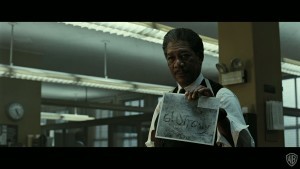
Morgan Freeman reviewing one of seven “discovery of the body scenes” in Se7en
[To read more of Shawn’s stuff, subscribe to www.storygrid.com]
The one concept I discuss in The Story Grid that captures everyone’s attention is the idea that every single genre has conventions and obligatory scenes. And if you do not deliver those conventions and obligatory scenes to readers, your Story won’t work.
Just the other day I was taping a Podcast with my friend Tim Grahl and Cs and OSs came up yet again. Tim asked me to start up a Story Grid podcast so that he could hammer me with questions about how he could take his idea for a novel and turn it into a first draft.
From first idea to first draft hooked me immediately.
We’ve taped five episodes so far, you can listen to the first one here, iTunes link is here, and we’re having a blast. We both committed to do ten episodes. (If there’s demand for more, i.e. a compelling number of subscribers, we’ll figure out a way to keep it going…)
So of course the question came up “Where should I start?”
In The Story Grid book, I suggest one way to get going…by diligently filling in the entire Foolscap Global Story Grid page before you start writing scenes.
And that’s my ironclad suggestion for all of you “pantsers” out there.
You are the kind of writers who don’t much like planning…those who would rather riff than come up with a global map for your story before setting off to parts unknown. You’ll do anything but plan. That’s your form of Resistance, refusing to map a course for your story keeps you from ever completing a true first draft. You fly by the seat of your pants. So the way to beat Resistance for you is to knuckle down and engage the other side of your brain…before you unleash the creative scribbler.
But what about all of those obsessive “plotters” out there? These are the writers who’ll spend years doing character histories and hundred page outlines that never seem to wrap up to THE END. What ails you is a major Resistance to actual writing. You want to analyze stuff to death and never feel like you have all of your ducks in a row to actually let yourself go and bang something out.
Telling “plotters” to fill in the Foolscap Global Story Grid is not such good advice. The reason? They’ll take years to get it “just right” before they begin…if they ever do.
So where should these people start?
I’ve been thinking about that ever since Black Irish came out with The Story Grid.
Tim Grahl admitted that he was absolutely in the “plotter” camp after I hit him with this idea. He almost began hyperventilating on the podcast when I told him the first thing he should do to start his novel is to write a scene. Because he was sure I was going to tell him to fill out his Foolscap… I mean he was attracted to The Story Grid because of its practical analytical work and here I was telling him to bang out a scene.
But not just any kind of scene.
I suggested that he pick an obligatory scene from his chosen genre…a crucial one that he’d have to really nail to get people interested in his story. And work on that first before he started filling in his Foolscap.
Why?
Obligatory scenes are a great way in to not just practice writing but to flesh out your driving “what if?” idea for your novel. It’s purposeful play. When you’re done, you’ll have a killer scene that you can use in your actual novel. And I have no doubt whatsoever that if you get into one of these tasks, take it very seriously and allow yourself the freedom to riff and explore and not settle for the first thing that tumbles out of your cerebral cortex, you’ll probably find a whole slew of ideas that will inspire you well beyond your initial “what if?”
So how do you actually do this?
Take one of the obligatory scenes below, map out a bunch of ways to solve it, and then write it.
Here are three obligatory scenes for three different external genres to get you started.
In every CRIME Story there is a DISCOVERY OF THE BODY/CRIME scene.
A map for this scene could be… A tomcat comes into a typical suburban family kitchen at breakfast time. Dad hears the tell-tale meow of his pet and goes to the refrigerator to get his companion his a.m.milk. Dad pours milk in saucer, and just as he sets it down, he discovers that his cat is drenched in blood. It’s as if the cat fell into a swimming pool of plasma, found some desperate way out and then made a beeline into the house. That’s one idea. Try some others.
In every LOVE Story there is a LOVERS’ BREAK UP scene.
A map for this scene could be… A man and a woman in the middle of being chased. They dodge an oncoming motorcycle. The woman falls. The man reaches down to grab her hand. As they’re dodging bullets from behind, she says to him…”Thanks!… But I don’t think we should see each other anymore.” There’s one idea. Do ten more.
In every PERFORMANCE Story there is a PROTAGONIST GETS THE GIG scene.
A map for this scene could be… A CEO is standing in front of a board or directors. It’s the annual meeting and the company is hemorrhaging money. He sees to the side that his assistant is waving at him furiously. He excuses himself for a moment, walks over and the assistant whispers “The Comedy Story called…Amy Schumer can’t do her set tonight and they want you to take it…what should I tell them?”
Get it? Do a few quick sketches and then just bang something out. Repeat until you’re in love.
Here are some examples of these scenes from popular culture.
In Andrew Kevin Walker’s script SE7EN, he makes the “DISCOVERY OF THE BODY” scenes the narrative engine of his entire story. There’s a serial killer loose. He’s inspired by the seven deadly sins…gluttony, greed, wrath, envy, sloth, pride and lust. Each one of those sins results in a murder and the discovery of the body for each becomes Walker’s writing challenge. He saves the last discovery as the culmination/ending payoff for the entire work.
To say that Walker innovated and raised the bar on DISCOVERY OF THE BODY obligatory scenes is the understatement of my career.
Don’t tell me it’s impossible to create something fresh from what one would think is a run of the mill formulaic scene obligation. Walker did it SEVEN TIMES!
In James L. Brooks’ screenplay based on Larry McMurtry’s novel TERMS OF ENDEARMENT, the LOVERS’ BREAK UP scene is so perfectly constructed and so unsentimental, it’s heartbreaking. It features Aurora Greenway, played by Shirley MacLaine, and Garrett Breedlove, played by Jack Nicholson.
Aurora has just watched her daughter and grandchildren drive away from her, they’re moving to another state, and the guy she loves who lives next door shows up. He asks to speak with her privately. They go back to the little gazebo in Aurora’s backyard and she knows what he’s going to say before he says it. The entire scene dazzles because at no point does he actually say…I don’t want to see you anymore…I’m breaking up with you. It’s all in the subtext.
These two people are so perfect for each other and they understand each other so well, that the necessity of actually saying “we’re over” is not required. Imagine the courage to write a break up scene without having the two people literally break up…to have so much respect for the audience that you spare them that obvious drivel?
In Damien Chazelle’s screenplay for WHIPLASH, the PROTAGONIST GETS THE GIG SCENE is hidden inside what viewers think is a reconciliation scene between the protagonist and his music teacher.
It’s an off-handed invitation that J.K. Simmons’ character Fletcher offers the awkward drummer/protégé Andrew at the end of reconciliation. “Hey, I’m doing this thing at Carnegie Hall…I need a drummer…you want to sit in?”
The invitation is a set-up and the climax of the movie devastating. Chazelle used the obligatory scene GETTING THE GIG as ammunition to blow up his ending payoff. Masterful.
I used screenplays as examples of obligatory scenes because it’s far easier to Netflix this stuff and get a sense of what these scenes are all about than to have to wade into novels to find them. All Story mediums—screenplay, short story, novel, play—require genre specific obligatory scenes and conventions. Look at them as Godsends, not limitations.
The bottom line here is that a great way to practice writing is to give yourself very specific scene tasks—pull out an obligatory scene from a favorite genre and write one up. Then re-write it in a different way. And again. If you keep doing it, I guarantee you’re going to find something locked inside your brain that will be remarkable.
[To read more of Shawn’s stuff, subscribe to www.storygrid.com]
October 14, 2015
The #1 Way I Screw Myself Up
We all have bad habits as writers. Here’s my worst: I have a terrible tendency to back off on the money shot.

Cher and Nicolas Cage in “Moonstruck” by John Patrick Shanley
Meaning I’ll fail to maximize the drama in key scenes.
I know why I do this. It’s Resistance. Fear of success. Fear of making something really kick ass.
But I still do it. Even knowing this is my Bad Tendency, I still go soft on the accelerator pedal.
It’s a terrible habit.
Here are two examples, both from my book Killing Rommel.
There was a character in the book named Stein. Stein was far and away the best and most interesting character.
I killed him off a third of the way through.
When the book got optioned for a movie, I teamed up with Randall Wallace (“Braveheart”) to write the screenplay. The first thing Randy said was, “We gotta keep Stein alive.”
All I could do was kick myself. Of course! Why did I kill him off in the first place?
Killing Rommel is about a British Special Forces patrol in North Africa during World War II that is assigned to go behind the German lines and attempt to eliminate the Afrika Korps’ brilliant and charismatic commander, Gen. Irwin Rommel.
I did twelve drafts.
In the first nine, the patrol never reaches Rommel.
There’s no scene, nothing, between our primary characters and the man they’ve spent 350 pages trying to get to.
What was I thinking?
Even when this scene finally occurred to me (at Draft #10), I resisted it. It took me a week to talk myself into writing it.
The scene of course is the single indispensable moment of the whole book. It’s the climax to everything. To not have it would be like writing Moby Dick and never having Ahab come face to face with the White Whale.
But still I resisted. “Won’t that be too obvious? Too expected? Isn’t it too ‘on the nose?'”
Here are a few other ways I’ll screw myself up, driven by this same instinct to back off, to soft-pedal:
I’ll underplay critical scenes.
I’ll make the dialogue too oblique. Too subtle. I’ll back off from the critical moment or fail to go all-out to make it play.
Here, as an example, is the right way to do it, from Moonstruck by John Patrick Shanley. This is Nicolas Cage as Ronny Cammareri to Cher as Loretta Castorini, on the sidewalk outside his apartment, midnight and freezing:
RONNY
Loretta, I love you. Not like they told you love is, and I didn’t know this either, but love don’t make things nice – it ruins everything. It breaks your heart. It makes things a mess. We aren’t here to make things perfect. Snowflakes are perfect. Stars are perfect. Not us. Not us! We are here to ruin ourselves and break our hearts and love the wrong people and die. The storybooks are bullshit! Now I want you to come upstairs with me and get in my bed!
I’ll have key scenes happen off-screen.
I’ll leave crucial moments out completely.
These are bad, bad habits.
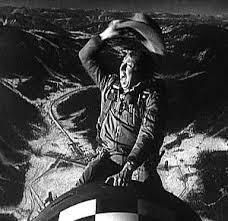
Slim Pickens in the all-time great Money Shot
To break myself of them, I remind myself of the all-time greatest go-for-it moment in movie history—Slim Pickens as B-52 pilot Major T.J. “King” Kong, waving his ten-gallon hat and whooping like a rodeo cowboy as he straddles the H-bomb that will set off the Russian Doomsday Machine and destroy the world and rides it, like a bronco, down to impact.
(Here’s the link).
I have no idea what contributions the three credited writers on Dr. Strangelove made to that scene—Terry Southern, Stanley Kubrick, and Peter George (who wrote the novel from which the movie comes, Red Alert)—but clearly the story objective could have been satisfied with a lot less brilliance. The bomb could have simply dropped. The plane could have been shot down or run out of fuel and crashed with the bomb armed inside it.
Either of those alternatives, or others, would have worked.
But how great was it that these writers put their foot on the gas and gave that moment horsepower on top of horsepower?
They went for it.
They held nothing back.
And no one—no one—who saw that scene will ever forget it.
I remind myself of that moment every time I’m tempted by my own Resistance to go soft on a Big Moment or to back off from taking the money shot.
October 9, 2015
Are You Ready For Mama?
Luther and Bobby stole their cousin’s new lawnmower.
The plan: The cousin would file a claim. The insurance company would send a check. The cousin would split the check with Luther and Bobby. Luther and Bobby would return the lawnmower to the cousin.
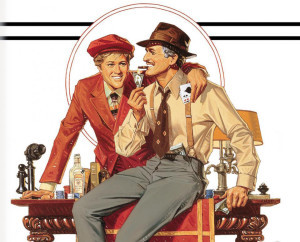
Johnny Hooker and Henry Gondorff made scamming look good. Credit: Movie poster for THE STING.
When their half-baked schemes weren’t landing them in jail, they were selling their plasma or sorting out other ways to make a dime.
Gaming the system was the one thing they came by honestly. Their parents had been working the disability arena their entire lives. They were raised as gamers. Mama had the mad scamming skills of Johnny Hooker and Henry Gondorff, but on the redneck, not-so-good-looking, side of the tracks.
Luther was Molly’s boyfriend and Molly was my best friend in high school. I watched their games as a third wheel, not wanting to be there, but not wanting to bail on Molly—which ended up happening anyway. I went from being amused by Scheming and Stupid to being scared.
It was amusing when Molly’s dad asked Luther where he went to college.
Dad: Where’d you go to school, son?
Luther: Penn State.
The reality: Switch Penn State to State Penn—or State Penitentiary. It wasn’t a lie. It just wasn’t the Penn State Molly’s Dad had in mind.
Amusing stopped and Scared stepped in when a gun came out during a routine argument. Usually they just called Social Services or another agency on each other—or on one of their family members. Pissed off at Mama? Call Social Services on her. Pissed off at Bobby? Call the police for a disturbance.
Jail seems a safe bet for where they are now.
The other option is trolling.
Mama was a wicked woman. Hate ran thicker than blood through her veins. Molly used to say that when she died, they wouldn’t have to embalm her because her blood was already 190 proof.
I imagine her behind a keyboard, spewing shit at every person she despises.
I didn’t want anything to do with her then. Now… She comes to mind all the time.
Mama and her clan of Crazy rise to the top when I’m facing trolls.

Mama don’t mess around. Credit: Screen shot from the film THE GOONIES.
I know that if I reply, Mama will head to the fridge for her box of wine, fill up her guzzler glass, and settle in for the long haul, a twinkle in her eye and a smile on her face in the seconds before she unleashes the Hell that is her mind.
If you’re on the other side of her screen, are you ready for Mama?
The thing about Mama is that she don’t mess with small fries (unless they get in her way). Gotta be a dollar involved.
If she don’t know your name, she ain’t gonna bother. So if you’re still building your “thing,” consider yourself safe.
If your new book or film — or whatever — is about to launch (anything that puts you in the public eye), consider yourself forewarned.
The bigger you are, the bigger your target becomes.
Are you protected?
Having a lawyer on hand is healthy. On your own, though . . . Ignore Mama, which is the course we’ve taken at Black Irish Books. We don’t engage. Mama is hard to ignore. If you can get by her, great. If you engage . . . You’re gonna end up a mess, even if all you’re doing is defending yourself.
Sometimes Ego comes in and wants to shut down the Trolls. Mama will not be shut down. In an alternate universe the role of the Energizer Bunny is played by her. She’ll keep going until her battery has died, her cord unplugged.
If Ego steps forward, remind him of the time it takes to respond to Mama. Remind him that Mama is a professional scammer. She’s not lazy, but instead of putting her powers toward good and obtaining what she’d like through a career, she’s focused on destruction. She WILL wear you down. She WILL suck your time until you have none left for what’s important. She WILL keep going until she sees you destroyed or gets what she wants (which are usually the same thing). She IS a vampire and WILL try to take your life.
Consider yourself warned. Arm yourself with a lawyer and a troll shield. Mama’s out there ready to destroy you.
Are you ready to ignore Mama?
October 7, 2015
Beautiful Losers
People write me letters sometimes. Wannabe musicians, aspiring novelists; I’m sure you know what I’m talking about.
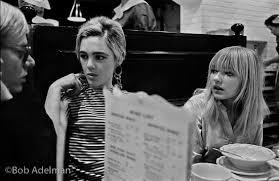
Andy Warhol and friends at Max’s Kansas City
These letters purport to be seeking counsel. The writer details his or her struggles with deciding which creative field to pursue, their frustrations with their own indecisiveness, with getting their art going, etc. Then they ask for advice.
Now, there’s a good way to ask for advice. The good way is when the person is earnest, sincere; he or she can, in truth, profit from a boost of encouragement or an impartial reality check. That’s the good kind of advice-asking.
But that’s not what these other letter writers want.
I can’t tell you how dispiriting it is to receive such missives. They reek of mental weakness, shallow superiority, and an impenetrable mantle of self-delusion and self-indulgence. Worse, they’re “hooks.” Meaning their aim is to steal a piece of the recipient’s soul.
For years I took these cries for aid seriously. I’d ask myself, How can I help? What wisdom can I impart? The poor letter-writer seems to be suffering so.
Then one day I realized, These characters aren’t really looking for help. They love the state they’re in. They’re wallowing blissfully.
They are Beautiful Losers.
The 70s in New York (even if you weren’t there, you have a sense of that era, I’m sure) was the golden age of the Beautiful Loser. CBGB’s, Max’s Kansas City, Andy Warhol’s Factory, Lou Reed and the Velvet Underground, the Ramones. Crime was rampant, night life was incandescent, fashion re-invented itself minute-by-minute.
The world of Beautiful Losers is a sphere of posing and posturing, of faux accomplishment and genuine despair.
How do I know?
Because I’ve been there myself, and for a lot longer than I care to admit.
The Beautiful Loser is in love with her own Resistance. The state of self-dissatisfaction, even self-loathing, that arises when we fail ourselves as artists and as human beings is interpreted in the Beautiful Loser lexicon to be hip, glamorous, existential ennui. It becomes in the Beautiful Loser’s mind a badge of distinction, a sign of her own exceptionalism.
It can be tremendously seductive, the idea of being soul-broken, discarded, misunderstood. See New Wave cinema, punk rock, heroin chic, not to mention much of contemporary fashion. It’s a billion-dollar industry, manufacturing and distributing the wan, neurasthenic, faux-suicidal look and the clothes and cosmetics that go with it.
The conceit of the Beautiful Loser is that he/she carries with them as a form of self-advertisement their own untapped and unexploited potential. (That’s why it helps to be beautiful.) The idea is that one’s unexplored What-I-Could-Be-If-I-Cared is more glamorous (and more erotically alluring) than the inevitably less-than-cosmic achievement that one might produce if he/she actually tried.
I have no sympathy any more for Beautiful Losers.
I destroy their letters and e-mails instantly. They’re bad news. Bad karma. I don’t want them around me, even crumpled in my trashcan.
I wrote a post a few weeks back called “Resistance and Hooks.” These loser letters are hooks.
The writer is seeking a response.
The problem is that no response will make a dent. A kick-them-in-the-ass reply will simply be perused with bemused disdain and discarded. A kindly-intentioned reply, something meant to provide encouragement and understanding, will be received with even greater condescension. The Beautiful Loser will experience mild (very mild) titillation for less than the time it takes to read the response, then turn to Instagram (or the B.L. beside them) seeking the next distraction.
Nothing will change, because the Beautiful Loser doesn’t want to change. She’s happy marinating in her shadow persona, creating the shadow work of art that is her life.
I know those lives. I understand them. They can be fun. They can be romantic and glamorous and dramatic. For a while. The problem with exceeding the expiration date is that you are selling out your daimon.
Unwritten plays and unpainted canvases possess a life of their own. They will turn on you. They will come back and make you pay.
I’d rather give five bucks to a panhandler on the street than waste a millisecond on one of these sallow and shallow mofo’s. In the end, the only person for whom they have greater contempt than themselves is you (i.e., the positively-projected version of themselves), if you’re foolish enough to try to help them.
October 2, 2015
Storygridding
For a while now, over at www.storygrid.com I’ve been writing about Malcolm

September 1, 1939
Gladwell and his first book The Tipping Point.
I’m doing something that I call “storygridding it.” And that’s just my short hand for creating a revealing infographic that a writer can look at lickety-split for inspiration.
And if she gets stuck writing her Big Idea nonfiction book, she can look deeply into the data of the story grid. And that data will reveal how a fellow scribe solved the same problem that she’s battling.
So say, you’re writing a thriller and you don’t know when to drop in the obligatory “hero at the mercy of the villain” scene. You can look at the Story Grid for The Silence of the Lambs and see where Thomas Harris put his. Knowing that story masters face the same dilemmas you face and seeing exactly how they confronted and defeated those same problems is a cathartic experience.
What you discover is truth.
You discover that the problems driving you mad are just problems. Not your own deeply ingrained character defects. You discover the truth that with a little elbow grease and perseverance (and don’t tell anyone, but fun too), your writing problems can be solved.
If you can’t identity the problems though, (you can’t see them through the thousands of words that they hide behind) what happens is you lash out at the idiot who just can’t get anything right.
And you know who that is right?
It’s you, you think, the talentless, lazy fraud of a writer that is just kidding themselves that they could possible create a thriller that has any resemblance to The Silence of the Lambs.
I’m here to tell you that thinking is bullshit.
To be more specific, it’s Resistance. It’s a hugely powerful form of Resistance that every single pro faces too. I promise you that Thomas Harris stared down that bastard himself before, during and after he wrote The Silence of the Lambs. He’s still fighting him. Just like the rest of us.
What settles me is the knowledge that story grids ground us to the realities of the creative process—that there are systematic ways to take a brilliant idea with a lot of niggly problems deeply burrowed into it, like parasitic worms, and then one by one surgically remove them.
So that’s what story grids are all about…giving writers a practical blue-collar way to improve. No meditation or opening oneself up to the mysteries of the universe so that one can be a vessel for an otherworldly force required.
The Muse isn’t here to use you like a typewriter. She’s your cut man. And if you ain’t fighting hard, there are plenty of other mooks stepping in the ring for her to help. She’ll come back not when you’re ready to do the work, but when you’re actually doing the work, not before.
Story grids are fight plans, after action reports, Monday morning quarterbacking sessions. They’re Bobby Fisher’s queen sacrifice strategy from 1956, Bobby Orr’s textbook give and go goal in the 1970 Stanley Cup, the to-the-second planned quick strike Israeli Air Force bombing raid that launched the Six-Day War.
Story grids are the work plans behind the “magical” expressions of human genius. The stuff grinded over for 10,000 hours that allows the artist to forget all of it in that critical moment called Performance.
You don’t have to ask Joe Namath what he was thinking when he launched the 52 yard fourth quarter bomb to fellow New York Jet Don Maynard in the 1968 playoff game against the Oakland Raiders of find out what Bob Dylan had for breakfast the day he wrote It’s Alright Ma (I’m Only Bleeding) or find audio of United Farm Workers’ Cesar Chavez referencing the techniques of Edward Bernays when planning the use of Boycotts to effect change.
Chances are they’ll have no answer for you anyway. Or their answers will be unsatisfying, cliché, boring… They did all of the work before the performance, not during.
A diver doesn’t think about the training it took her to be able to execute the perfect tuck when she’s about to launch off the ten meter platform. She trusts the work, relaxes and let’s her muscle memory take over.
This is why we need translators. People who make it their mission to look at works of art in different ways, practical ways that make sense to artists in training. People who X-ray the work and detail how it’s put together.
This is what storygridding is about. It’s a way for people cranking out hour number 5,231 to learn from the craft underneath the work they admire. The things the journalist and writer Gladwell did to train his writing muscles before he wrote The Tipping Point. The stuff he forgets today that he did yesterday.
One of my favorite commenters over at www.storygrid.com put forth the idea that all of my analysis doesn’t mean much if I don’t interview and confirm all of my thoughts with Mr. Gladwell and his agent Tina Bennett. If I’m not able to get Gladwell and Bennett to confirm or deny how I propose they worked separately and together to create and market The Tipping Point to publishers, then my work will settle on the value line graph alongside the benefits of noxious gas emitted from anxious canines.
Perhaps.
Here’s the thing. It’s been my experience that the artist’s methodology is his secret sauce. The way he cleans his desk. The kind of pencil he uses. The prayers of invocation before the work begins. And that’s the stuff they are loath to talk about. For good reason. For them and for us, they are magical. Let them be so.
The only thing they like to talk about less (or even remember or care to remember) is all of the bloody work they had to do before settling in to their profession. I’ve edited and published so many books by so many amazing performers who were as interested in talking about how they learned their craft as Tom Brady is talking about football inflation. They want to talk about the performance, of how it came out of them with grace and beauty. And that’s what most people want to read about too.
God knows we can’t bring back W.H. Auden and ask him about how he wrote “September 1, 1939.” We just have the work to consider. I put forth that the work is all we need. Auden, God bless him, was the corporal force that brought it forth, but the work is all that matters.
Good arguments right? But come on, why don’t I just make those calls and get the “truth?”
Alright then. Here’s the real reason why.
I’m not really writing about Malcolm Gladwell or Tina Bennett or Thomas Harris or any of the other characters that inhabit corporate book publishing.
September 30, 2015
All Storytelling is About Metaphor
A boxer takes a haymaker to the jaw. He falls. He struggles to one knee as the ref stands over him, counting, ” … two, three, four … ” Watch the faces in the arena. They have become that fighter. He is living their life, their struggle.
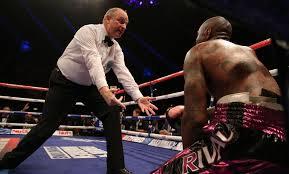
You are that fighter
That’s metaphor. That’s art.
You, the artist, are that fighter. You enact via your struggle (and the struggle of the characters you create), the life drama of those who look on as you fight. When we speak of “finding our own voice,” we’re not talking about finding our petty, selfish voice, mewling and sniveling about our own selfish shit. The voice we’re seeking is much bigger. It’s noble. It’s generous. It’s universal. It does not inflict itself upon the reader for its own self-interested reasons. Instead it seduces, intoxicates and incorporates the reader into a tale told of the reader and for the reader.
Your protagonist is not you. Your protagonist is the reader. You are not telling your story for yourself. You’re telling it for her. You’re telling her life story. You’re expressing her pain, her longing, her struggle.
Can you be that artist? Can you become that boxer? Can you train yourself and discipline yourself and motivate yourself to be good enough to merit a fight in an arena, a contest that people will buy tickets to see? Have you got the speed, the strength, the mental toughness?
Are you that fighter?
September 25, 2015
Always Come Out of Another Hole
[I forgot about this post from Aug. 30, 2013, until I ran into Kevin Spacey’s speech again. Take a look and scroll down for Sir David Lean, too. For as much as things change, they stay the same. — Callie]
At about the 1:20 mark in Kevin Spacey’s MacTaggart Lecture, given during the Edinburgh International Television Festival, he looks straight into the audience and says, “It’s the Creatives, Stupid.”
It’s a television festival, so he keeps on the “television” theme, but that deeper thread is about change and taking risks.
When facing one of his first offers for a television role, he contacted his mentor, Jack Lemmon. He wasn’t sure that he wanted to take part in a television program that network execs had their hands all over—poking here and there within the creative process . . .
So . . . he calls Jack, and asks him about those “golden years of television” that Jack always spoke about—those years when Jack had first started out. “Was he being nostalgic or was there something different about the way television was back then?” Jack replied:
You have to understand, kid, that television was brand new back then. I mean, it was a new medium and nobody knew if it was gonna last—so you could try anything. Comedy one week … a drama the next… a musical… I mean…. It was terrific. It hadn’t been commercialized yet and no one knew it was going to be around that long. There was this sense of total abandon. Total abandon.
Total abandon. . . Not exactly the words we think of when television, films, music, books, or any other “creative industry” is mentioned today.
Within his talk. Kevin also mentions attending the 1990 American Film Institute Lifetime Achievement award for Sir David Lean—and how Sir David “dedicated his acceptance speech to the idea of promoting and supporting emerging talent. It turns out he was concerned, perhaps frightened by the film industry’s lack of commitment to developing talent and the greater and greater number of films the studios were making that appealed only to the pulse and not to the mind.”
Only to the pulse . . . not the mind . . .
Kevin goes on to quote some of Sir David’s speech. I’ve pulled the entire speech, as there are some nuggets that were left out:
Noel Coward once said to me during our early days, “My Dear, always come out of another hole.” Now, he said a lot of other things, but, I find myself thinking that nearly everything he told me—and everything I learned—in those early days seems to be contradicted today. We don’t come out of any more new holes. We try to go back and we come out of the old holes—parts I, II, III and IV. And I think it’s terribly, terribly sad.
Looking at this list here, in this wonderful program . . . Nearly everybody there is an innovator, a pathfinder. They found new things to do in the movies—and all of us live on new things. Okay. Do old things—parts I, II and III—but don’t make them a staple diet. We’ll sink if we do.
This business lives on creative pathfinders—and there are a whole lot of you here. I terribly miss—we all miss, I think—somebody like Irving Thalberg. He had a foot in both camps. He understood us people, and he understood the money people.
We’re in terrible danger. I think there are some wonderful new filmmakers coming up now. They are going to be our future. Please, you chaps in the money department, remember what they are. It’s a very nervous, nervous job making a film. They need help.
I would like to read you something. It came from my old friend, Fred Zinnemann. He found something that was said by Irving Thalberg. He said, “The studio has made a lot of money—and they could afford to lose some.”
I think the time has come where the money people can afford to lose a little money, taking risks with these new film makers. I think if they give them a break, give them encouragement, we’re going to come up and up and up. If we don’t, we’re going to go down and television’s gonna take over. (laughter from the audience here) Anyhow . . . Wish them luck—I do.
It’s interesting, that in 1990 he spoke about television taking over film, and now we’re seeing television being eclipsed by non-traditional creative outlets—like Netflix. And Netflix, of course, is the outlet that brought us Kevin’s House of Cards.
This past week, Netflix has been in the news quite a bit. Its programming is up for 14 Emmys—and it’s inking headline-making deals.
Netflix came out of a new hole—and further confirmed that consumers don’t care about the medium. They care about the story.
“If you watch a TV show on your iPad, is it no longer a TV show?” Kevin asks later in his speech. “The device and length are irrelevant … For kids growing up now there’s no difference watching Avatar on an iPad or watching YouTube on a TV and watching Game Of Thrones on their computer. It’s all content. It’s all story.”
In the Los Angeles Times article “Netflix executive upends Hollywood,” Academy of Television Arts and Sciences Chairman Bruce Rosenblum said:
Television no longer refers to the box sitting in your living room—television refers to storytelling. The method by which our viewers experience those stories is truly irrelevant.
Yep.
Within that same Times article, director David Fincher’s response to Netflix releasing all 13 House of Cards episodes at once is shared:
“My attitude was, that sounds awesome,” Fincher says. “As television becomes more and more like literature, I’d love to be able to set the book by the nightstand when I want to. It seemed like the natural progression of things.”
That’s interesting, isn’t it? A television show as a book. Makes sense. It’s hard enough to wait for the next book in a series to be released. I don’t know that I could handle it if the book was released chapter by chapter. I’d want it all. At once. I want my books in “binge-happy bundles”—which is how the Times described Netflix’s all-at-once release method. And, I’d say, I’d take the binge-happy bundle for film and television, too.
Binge-happy should apply to multiple formats, too.
The tradition in publishing is to release the hardcover, then the paperback. When audiobooks started to rise, they inserted themselves in with the hardcover release—or just after the release—of the hardcover. E-books followed in audio’s footsteps.
With film, there was the theatrical release and then a delay between DVD and cable releases.
The fear is that if all of the formats are released at once, the ones that often make the publishing houses and studios money—the hardcover and ticket showings—won’t be bought or attended.
But, we do continue to buy the hardcover or go to the theaters, because there’s something special about them.
I cherish the copy of Profiles in Courage that my father inscribed to me. I’m looking forward to passing down my hardcover set of Nancy Drew books to my daughter, when she is old enough to read them. And, my son has already filched numerous books off of my office shelves. I can’t imagine holding onto an e-book with the same memories, not being able to pass on yellowed, dog-eared pages I once turned for my daughter to turn herself, or having my son try to pull something off my iTunes library instead of my physical shelf. It’s the romance and the community.
In the same vein, John Murphy wrote about the “communal experience of experiencing something with a roomful of moviegoers ” in his piece The Future of Movies:
I actually find the human connection we get from great stories and entertainment even more special. It’s like the “water cooler” days of Seinfeld, when coworkers would reminisce about last night’s episode around the water cooler at the office or on the factory floor. It’s that shared, after-the-fact connection that brings us together. . . Whenever I see something great I tell friends to see it. And when you meet someone who has seen something you love, you instantly connect. You discuss its qualities. You discuss how it surprised you, or touched you, or shocked you, or made you laugh until you peed a little. The movie or the TV show or the YouTube video or the Vine or the novel or the Tweet or whatever—it connects you to other human beings in an increasingly disconnected world.
So that focus on providing one format at a time? Shouldn’t be a concern if the story is a good one.
“I knew the stakes were high, in terms of the size of the bet,” said Ted Sarandos, chief content officer for Netflix, in the Times story. “But if we believe all those things we say we believe in— that television is going to be mostly on-demand and mostly delivered [digitally]—then someone had to lead that charge. It had to be something as good or better than anything on TV.”
It had to be a good story.
What does that story look like? What does the voice sound like? It’s not just the medium or the format that are changing.
In his book Chronicles, Bob Dylan wrote about working on an album with Danny Lanois.
“Danny asked me who I’d been listening to recently, and I told him Ice-T. He was surprised, but he shouldn’t have been. A few years earlier, Kurtis Blow, a rapper from Brooklyn who had a hit out called “The Breaks,” had asked me to be on one of his records and he familiarized me with that stuff, Ice-T, Public Enemy, N.W.A., Run-D.M.C. These guys definitely weren’t standing around bullshitting. They were beating drums, tearing it up, hurling horses over cliffs. They were all poets and knew what was going on. Somebody different was bound to come along sooner or later who would know that world, been born and raised with it . . . be all of it and more. Someone with a chopped topped head and a power in the community. He’d be able to balance himself on one leg on a tightrope that stretched across the universe and you’d know him when he came—there’s be only one like him. The audience would go that way, and I couldn’t blame them. The kind of music that Danny and I were making was archaic. I didn’t tell him that, but that’s how I honestly felt. With Ice-T and Public Enemy, who were laying the tracks, a new performer was about to appear, and one unlike Presley. He wouldn’t be swinging his hips and staring at the lassies. He’d be doing it with hard words and he’d be working eighteen hours a day.”
The voices of our stories continue to change. They don’t always fit in the neat little Part III version of our favorite hole. They’re often scorned upon appearance—and then decades later called revolutionary. Hindsight… Don’t wait for it. Get the blinders off today.
The wrap-up
Four more lines from Bob Dylan, via The Times, They Are A’Changin‘:
Don’t stand in the doorway
Don’t block up the hall
For he that gets hurt
Will be he who has stalled
I don’t think he was referring to industry execs when he wrote the song, but they sure do apply.
Those who are stallin’? They look like Elmer Fudd staring down a rabbit hole. Thinks he’s a threat . . . Just a loud annoying guy wasting his time on an old hole, while Bugs always comes out of another hole. Bugs is the Creative, the Netflix, and Fudd is that old television station, movie studio, publishing house, music label . . .
Stop stallin’ and come out of another hole.



